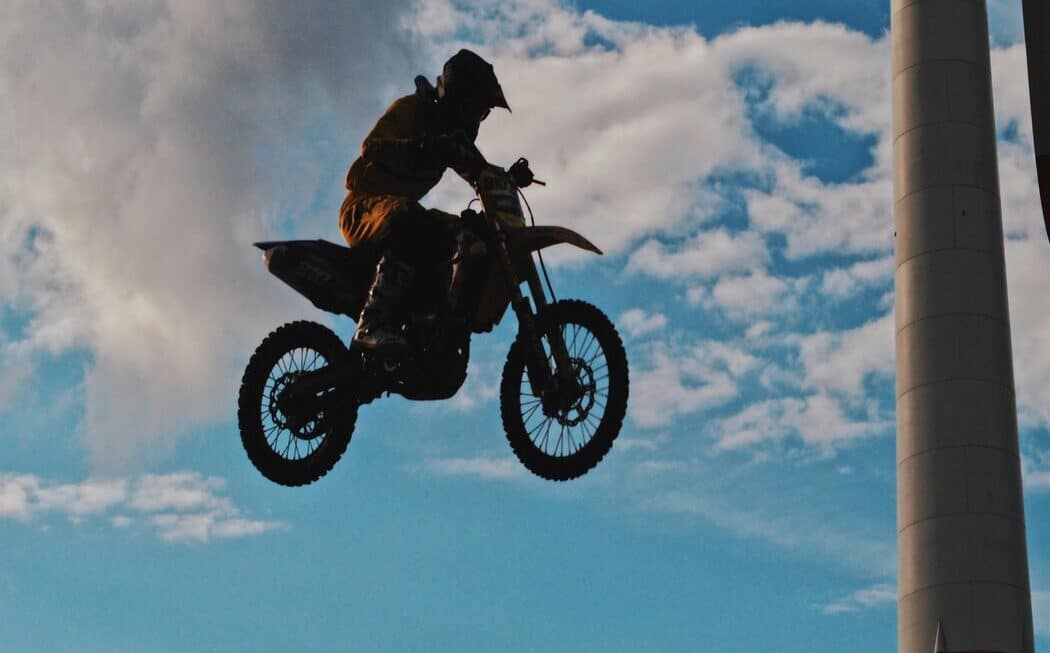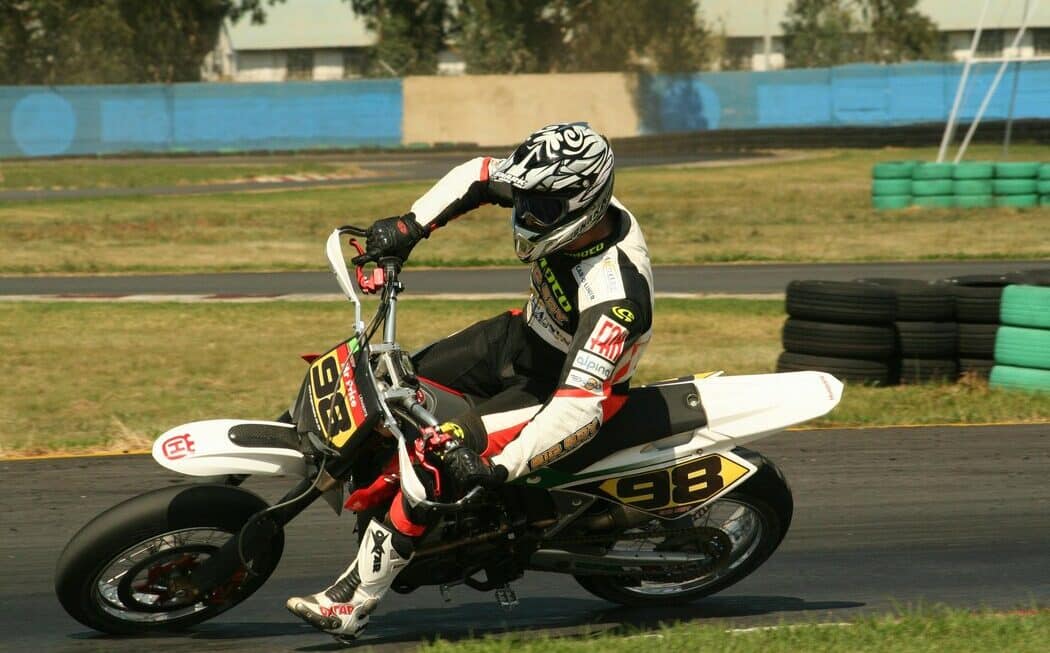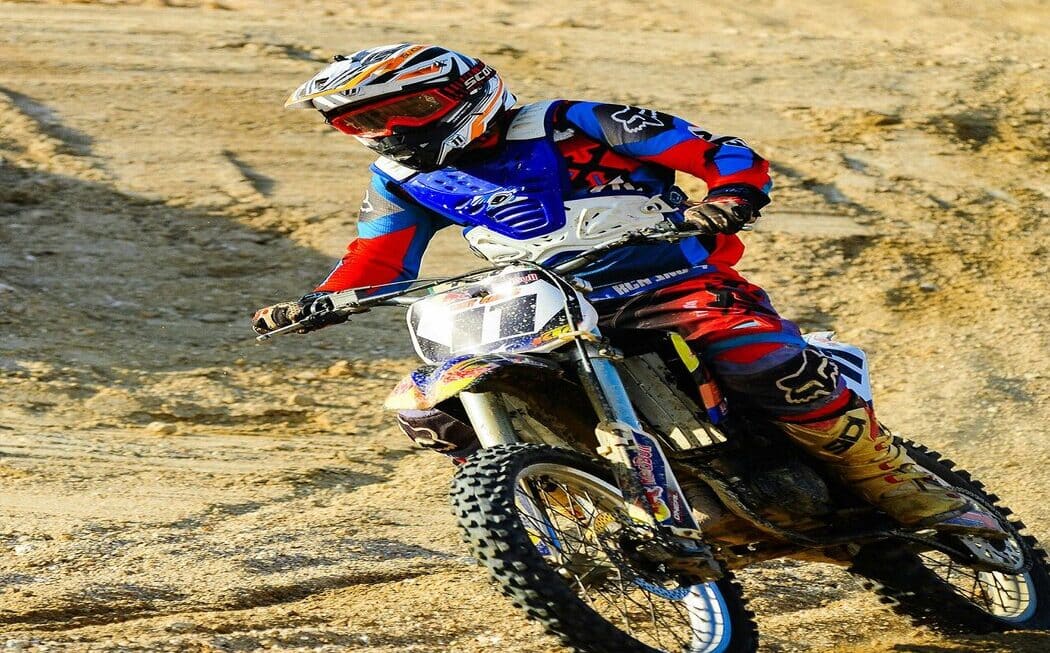Breaking in a new dirt bike is an essential part of the biking journey, and it could be one of the most daunting tasks you’ll encounter. To properly break in your bike, you’ll need to take some specific steps and follow a few key principles. A well-crafted break-in period is not only helpful for your new dirt bike, but it will also help get you riding with less risk of breakdowns or premature parts failure.
The best way to break in a new dirt bike is by running it at lighter loads and gradually increasing the load over time. This helps to reduce wear on engine components while also allowing the moving parts such as piston rings and valves to bed in properly. By sticking to these guidelines during your break-in period, you can ensure that you get many more years of performance out of your motorcycle without experiencing any common pitfalls along the way. Properly breaking in your dirt bike reduces wear and tear on components more efficiently as you ease them into use over some time rather than stretching them beyond their limits from day one.
How to Break in a New Dirt Bike?
Here are some guidelines and tips for breaking in a new dirt bike:
Timing and Mileage Game
It is an important part of a dirt bike’s lifespan. During the break-in period, it is crucial to stay within the time and mileage limits provided by the manufacturer. Generally, the first 500 miles or 10-20 hours are considered the break-in period during which riders should not exceed certain speeds, applying too much force on any single part of the bike may damage it after its life has begun.
During these initial hours and miles, engine components will settle into their appropriate positions which will ultimately result in improved performance later down the road. Here we have explained some measures; that will ensure that your new ride remains in peak condition for years to come!
Let the Engine Idle:
When you first fire up the engine of your bike, there are a few essential steps that should be taken before taking it on the open road. The first one is to let the engine idle for around 10 minutes. This time is critical in giving your engine the best chance of running efficiently and safely.
Idling allows the engine to warm up gradually and gives the oil time to circulate throughout all the components. This process ensures that once you do take your ride out, everything is properly lubricated and functioning as it should be. It also helps to prevent sudden breakdowns or excessive wear on certain parts due to a lack of lubrication from a cold start.
Light Riding:
It’s time to get out on the open road and enjoy the beauty of an unencumbered ride. The rush of wind through your hair, the hum of the engine, and the anticipation of a new adventure! But it’s important to remember that initial rides require moderation. It is wise to keep speed low and gradually increase as you become attuned to your vehicle. Likewise, heavy loads should be avoided until you are comfortable.
Take some time with your bike before pushing it past its limits. Start with small turns and minor obstacles; these will help familiarize you with maneuvering the handles and steering while assessing how much power it can handle. You may even find taking a riding lesson helpful to ensure that safety is always the priority: at slow speed or fast, nothing should take precedence over safety. When you feel ready, accelerate slowly and then rev up when appropriate for a smooth transition from light riding to full-throttle thrills!
Variety of RPMs
It’s important to vary your RPMs when riding a motorcycle, whether you’re just getting started or you’re a seasoned pro. This helps break in the bike by seating the piston rings properly and evenly distributing heat and lubrication between parts. To vary your RPMs, use different gears and throttle positions. When in lower gear, you don’t have to rev up the engine as hard, because you’ll naturally get higher RPMs. However, if you want to get maximum power out of your bike then it’s best to stay at or near the red line on the tachometer by using higher gears and more throttle position.
Practice makes perfect when it comes to controlling your RPMs. You don’t just want to take off like a wild bat out of hell, instead work up slowly until you find the sweet spot where your bike starts to shine. Like breaking in a new pair of shoes, make sure that you twist, turn, and jump around on the gear level or with the throttle until everything runs smoothly. Variation is key; as long as within reason for safety purposes – making sure not to overrev – experimentation should be embraced so that every ride is optimal from start to finish.
Avoid Extreme Conditions
One of the most important times to take care of your new vehicle is during the break-in phase. This is a period where you should avoid extreme conditions and focus on easing your engine into full capacity operation. To ensure that your engine runs for many years, adhere to the break-in program detailed in your car’s manual. During this program, harsh terrain or high temperatures and humidity should be avoided whenever possible. Dunes may look like great fun for off-roading, but they can place a heavy strain on your engine which can cause long-term damage. Additionally, rocky terrains should be avoided since they present the potential for harmful vibrations which can lead to premature mechanical failure.
Instead, stick to mild dirt roads and highways when driving during the break-in phase. Remember why you invested in a new car in the first place: because you want it to last forever! By taking appropriate caution and avoiding extreme conditions during its fragile infancy stage, your car will thrive and give many years of reliable service into the future!
Follow the Manufacturer’s Guidelines:
The most important thing to remember when dealing with dirt bikes is to follow the manufacturer’s guidelines. The owner’s manual should be consulted for specifics on safety, maintenance, assembly, and repair. Failure to do so can lead to dangerous situations and expensive repairs. Each bike is different and requires special attention to function properly. Ignoring the manufacturer’s instructions is like ignoring your grandma: you’ll likely end up regretting it sooner or later!
If a problem does arise with the bike that cannot be solved, it may be useful to consult our article on ten reasons why your dirt bike won’t start and how to fix it. Our article provides an informative overview of common problems and their solutions, enabling any user – even the casual one – the opportunity to fix their beloved machine without having to take it into a mechanic’s shop. By following the manufacturer’s guidelines and our easy-to-follow guide, almost any dirtbike issue can be resolved quickly and safely.
Monitor Fluid Levels
Regularly checking the fluid levels of your bike is an essential part of vehicle maintenance and one you shouldn’t neglect regardless of the type of ride you’ve been on. Checking the oil, coolant, and other lubricants after each ride will ensure that your engine remains smooth and healthy. When bike fluids are low, it can cause serious problems such as accelerated wear on metal parts or an overheating engine, so it’s a good idea to ensure everything is in order.
To monitor fluid levels accurately, it’s important to be aware of what levels they should be at. Different bikes may require different levels of maintenance and have distinct operating instructions when it comes to fluids—failure to continue monitoring the levels could lead to expensive repairs down the line. An easy way to keep track of levels is with dipsticks or sight-glass windows (which display fluid levels) that exist for different types of bikes across various models. Additionally, some products monitor fluid levels automatically, freeing you up from needing to check constantly yourself. Taking care of your bike and its fluids is one of the most basic ways to maintain a safe and efficient operation—don’t forget!
Break-In Milestones for Your New Dirt Bike
Breaking in a dirt bike is an important step on the road to safe and enjoyable riding. The break-in period is very important for both performance and longevity, as this is when you’re getting to know your new machine. An important part of this process is setting some milestones that you can easily track and measure how well you’re doing at breaking in the bike correctly.
Some examples of great break-in milestones include: after your first ride, check the oil levels, look for any leaks, and make sure all bolts are properly tightened; after 10 hours of riding, perform a more detailed inspection; it might even be a good time to give its first oil change. Setting these types of breaks ensures that you’re properly familiarizing yourself with your new dirt bike before taking it out onto tougher courses or trails. Taking the time to set these milestones will help keep you safe and also maximize your dirt biking experience by having smooth-running bikes consistently throughout their lifetime.
Understanding the Purpose of Break-In on a Two-Wheeler
Break-in is an essential process that needs to be done before riding any kind of two-wheeler, whether it’s a motorbike, installation motorcycle, or even an off-road motorcycle. The break-in period is extremely important for the long-term performance of the bike. The main aim of the break-in period is to ensure that the engine piston and piston rings are correctly placed into their respective positions, guaranteeing optimum engine function over many years of usage.
The break-in procedure ensures that both the driver and machine are used to each other properly and become familiar with one another in a safe environment. riders are encouraged to take their time during this period as it takes several hundred kilometres before an engine can reach its full potential at peak performance. To further optimize the break-in process, understanding concepts like cylinder capacity or horsepower will help you get accustomed to your bike more efficiently.
Warning Signs
As an experienced dirt bike rider, you know how important it is to stay alert of any potential warning signs during the engine heat cycle. Being aware of any minor fluctuations or changes in your bike’s performance can save you a lot of time and trouble down the road.
The most obvious sign of a problem is smoke coming from the engine or exhaust pipe. Some smoke is normal during normal thermal cycles, but if you see increased amounts of smoke it’s time to take a closer look at your bike’s system. Additionally, listen for any knocking, pinging, or strange sounds that may indicate underlying problems in the dirt bike’s engine. Temperature fluctuations are also not your friend so pay close attention to this. If the engine gets too hot, give it a cooling period before continuing use to avoid serious adverse consequences. Lastly, if leaks appear anywhere on your bike they should be addressed immediately as these can lead to more than just small issues; they can cause irreparable damage fairly quickly if not properly dealt with.
Time and Mileage for Break-In Procedure Steps
When it comes to break-in procedures for motorbikes or motocross bikes, timing and mileage are important considerations. Generally speaking, 10-20 hours of riding time is recommended, allowing the engine rings and other components to properly adjust. This period also allows for all of the parts to settle in which helps prevent any long-term damage from occurring.
High RPMs, frequent stops, and subjecting the bike to more extreme conditions should be avoided during that initial break-in period. The goal is to allow the components to slowly get used to running together while remaining at comfortable speeds. You don’t want to push it too far or else this could lead to costly repairs down the road and an overall decrease in performance quality. Following this general guideline will ensure that you not only have a safe ride but also get a good long life out of your motorbike or motocross bike!
Choosing the Right Terrain
When it comes to dirt biking, selecting the right terrain is critical. During the break-in phase, it is vitally important for riders to choose a flat and even terrain that won’t put too much strain on the bike or its engine. Any arduous or challenging tracks should be avoided until your motorcycle has been properly broken in. This is especially true for 2-stroke engines as they are more delicate and require careful handling.
Sticking to easy trails and avoiding difficult obstacles will ensure that your dirt bike’s engine remains free from premature wear and tear. It also allows you to become more familiar with the controls of your dirt bike to get used to adjusting speed, using brakes, leaning into corners and other balancing techniques without stressing yourself or your machine too much! Generally speaking, maintaining a steady pace on basic terrains is the best way forward when breaking in a new ride.
The Maintenance Schedule
Routine maintenance is often the unsung hero of a happy and safe biking experience. Without it, your bike won’t be able to perform to its full potential. Regularly changing the oil and air filter can make a huge difference in keeping the engine at peak performance. In addition, ensuring that everything is properly tightened will prevent you from having any mechanical problems while riding.
By following a regular maintenance schedule, you’ll be able to ensure that your bike is always running smoothly and efficiently. Not only will this allow you to enjoy every ride, but also potentially save money on repairs in the long run. Often though, people forget about their bike once they buy it or don’t know how to properly maintain it on their own. If this is the case for you, don’t hesitate to consult experienced professionals for help with any concerns or questions you may have!
Cooling Periods
Regular maintenance of your bike is important, but just as important is allowing your beloved two-wheeler to rest and “breathe” after a solid ride. Cooling periods are essential for preserving the life of your bike’s engine components, improving long-term performance, and avoiding excessive wear. Just like gym sets require a period of rest between each set to ensure maximum energy output, motorbike engines need a similar break to recover after tough rides.
Cooling down should take around 15-30 minutes depending on how hard you have been riding and the environment temperature. If you have been riding in hot ambient temperatures, letting your bike cool off for twice that amount gives the engine added protection ensuring it reaches close to the atmospheric conditions before starting up again. Not only does cooling off prolong engine life, but it also prevents seized or worn-out pistons from ruining expensive components such as cylinder barrels or crankshafts. Allow your motorbike some much-needed breathing room between rides by giving it appropriate cooling periods.
Keep a Record
Keeping a record of your break-in process on your bike can be invaluable. Some important things to document include mileage, RPM variations, and any changes you make to the settings such as the throttle or accelerator. When something feels off, having this information readily available makes it easier to go back and review what was done and if anything may have gone wrong during the break-in period. This is like having a black box for your break-in journey so you can refer back anytime to check for potential issues or successes.
In addition to monitoring any noticeable changes and recording them in a logbook, maintenance schedule upkeep is also important during the break-in period so everything runs smoothly. Keep records of engine heat cycles, thermal cycles, and other related procedures that you’ve performed on the bike as well as how they are affecting engine performance over time. This will give you an idea of how successful your efforts have been in terms of maintaining the bike’s performance level throughout its life cycle. By keeping these records detailed and current, future repair visits may take less effort since all pertinent information has already been logged!
Post-Break-In Tips
Congratulations! You have successfully broken in your new off-road motorcycle. Now you are ready to hit the trails and take on any type of terrain. After a break-in period, it is crucial to hone your skills by safely riding your new motorcycle.
To ensure an enjoyable ride experience, follow certain post-break-in tips that will enhance the life of your off-road motorcycle. Keep in mind that you must gradually increase the speed of your bike as you become more comfortable on it. Make sure to shift up and down through all gear regularly throughout each ride, allowing the engine to receive varied speeds so that maximum power output and shift performance is achieved once fully broken in. Additionally, continuously check all engine components including radiators, filters, or clamps for proper fitment as well as inspect tires for wear and tear. Finally, do not forget to top off your transmission oil levels before each ride as this minimizes premature wear on all moving parts and ensures smooth shifting between gears.
By implementing these simple tips after breaking in your new off-road motorcycle, you can enjoy a seamless riding experience no matter what type of terrain lies ahead of you!
Conclusion
When it comes to breaking in a dirt bike, the choice is easy: do it. Sure, it may be a time-consuming and patience-testing process, but the effort you put in now can pay dividends in the future. By taking your time and getting your bike fully prepared for whatever terrain or condition might come its way, you can feel secure that your adrenaline rush will be matched by reliable performance and durability.
With proper observation and adjustment, as well as the addition of knowledge and ability with every practice session, you’ll soon achieve a balance between skillful speed and safe control while out on the trail. Through that experience, you’ll become even more connected with your ride–unleashing ever more thrills along the great escapes that await those who dare go beyond! So embrace the breaking-in process today, it’s an investment worth making!
FAQs
Can I Use My Dirt Bike for Competitive Events Right After the Break-In?
Breaking in a new dirt bike is an important step before taking it out for competitive events. During the break-in period, you should aim to get your bike used to regular riding conditions and vary your speed and gears accordingly for a few hours. This will help your bike warm up its components gradually and reduce strain on the engine, making it more reliable for future use.
It is not recommended to use the dirt bike in a race or other competitive event right after the break-in period. Even though you may be tempted to test out the capabilities of your new vehicle, any strenuous activity during this time can cause premature wear on its components or affect performance later down the line. To ensure maximum efficiency of the dirt bike’s components, give it some time to adjust first by driving at normal speeds after break-in before pushing it into more extreme conditions during races or races.
What Are the Risks of Not Following a Proper Dirt Bike Break-In?
A properly broken-in dirt bike is essential for achieving optimal performance and long-term durability. Without following proper break-in procedures, the engine can suffer from uncomfortable rideability issues, premature wear, and potential failure. To maximize the efficiency of a dirt bike’s engine, the cylinders need to be carefully prepped by following a specific method for the duration of time outlined by the manufacturer.
Failing to follow the correct break-in protocol leaves engines particularly vulnerable to poor lubrication during warm-up periods. This can lead to rapid piston wear, cylinder scuffing, and overheating — all of which can reduce performance levels and cause expensive damage that needs to be fixed or replaced over time. It is important that riders keep an eye on their engine temperatures during break-in and not exceed recommended levels set by the dirt bike’s manufacturer. Furthermore, appropriate maintenance should be followed at regular intervals throughout ownership to ensure proper cylinder condition is being maintained at all times.



